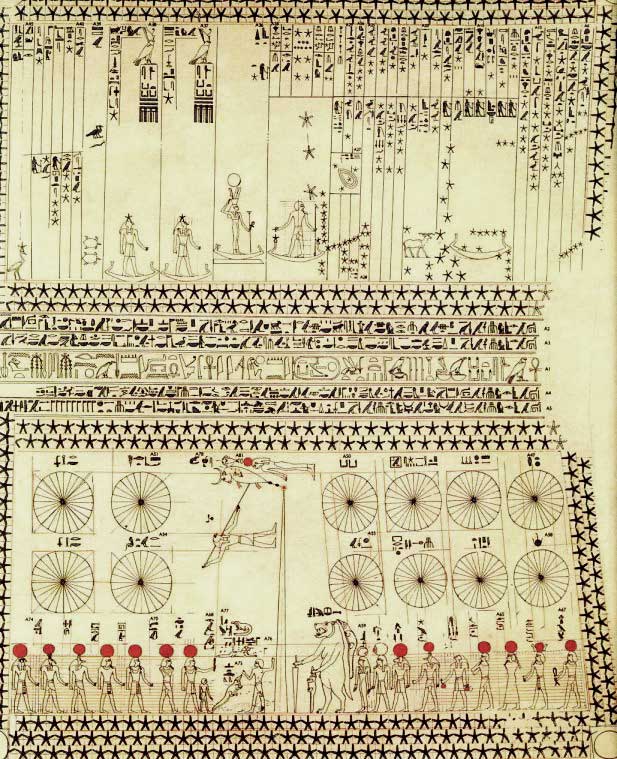Star Catalogues
Star catalogues are lists of stars. Many catalogues were compiled by ancient people.Examples of star catalogues
Ancient Egypt
In the ancient Near East (ancient Egypt) recorded the names only a few identifiable constellations used as a star clock. They were the 36 decans.

Ancient Greece and the Roman Empire
Many star catalogues were created at this time. They were compared against each other,, and the equinox was discovered after they noticed that the longitude changed over time. Ptolemy published a star catalogue that was used in the Western and Arab worlds for the next 800 words.

Bayer and Flamsteed catalogues
Two catalogues were created and introduced in the early 1600s. For the Bayer catalogue, each star was given a Greek letter followed by the genitive case of the constellation. However, for a large constellation, there were too few Greek letters that could be used. The Flamsteed catalogue solved this using lower-case Latin letters, followed by the upper-cased ones.
Full-sky catalogues
Full-sky catalogues try to list every star that is brighter than a certain magnitude as billions of stars can be detected by modern telescopes.
Histoire Céleste Française
Jérôme Lalande published the Histoire Céleste Française which contained 47390 stars up to a magnitude of 9 and was the most complete catalogue of its time. It was decently accurate, so it was used as a reference by observatories around the world throughout the 19th century.
Henry Draper Catalogue
The Henry Draper Catalogue was published between 1918 and 1224. It covers the whole sky to about the ninth or tenth magnitude and is the first large-scale attempt to catalogue spectral types of stars. It was compiled by Annie Hump Cannon and her co-workers at Harvard under the supervision of Edward Charles Pickering. It was named in honour of Henry Draper, whose widow donated the money required to finance it. HD numbers are widely used today for stars without a Bayer or Flamsteed designation.
Bright Star Catalogue
The Bright Star Catalogue catalogues stars up to a magnitude of 7.1. It was first published in 1930 as the Yale Catalog of Bright Stars. Its last printed version was the 4th Revised Edition, released in 1982.
USNO-B1.0
The USNO-B1.0 is an all-sky catalogue created bt the research and operations astrophysicists at the US Naval Observatory. It is used by NOMAD.
Guide Star Catalogue
The Guide Sat Catalogue is an online catalogue of stars produced for identifying stars that could be used as guide stars for the Hubble Telescope. It contains stars up to a magnitude of 21.

Astronomical naming conventions
Astronomers need to assign systematic designations to stars to be able to identify which star is which, and, if needed, their interesting features. Actual names can be used for the most interesting objects.
Bayer designations
Bayer designations order stars in a given constellation from the brightest down. They are in Greek alphabetical order.
Flamsteed designations
Flamsteed designations are ordered by right ascension numerically.
Bright Star designations
Stars in this catalogue are designated as HRXXXX or BSXXXX. There are 9110 entries in this catalogue. It includes most stars brighter than magnitude 6.5.
Henry Draper designations
Stars here are designated as HDXXXXXX contains positions, spectral types and magnitudes of about 225000 stars to around the ninth magnitude.
Durchmusterung catalogues
Stars here start with DMsdd XXXX. Sdd is the declination and XXXX is the running number in that designation band, starting at 0 hours right ascension.
SAO designations
Stars in this catalogue catalogues 250000 stars to about the tenth magnitude. They are designated with SAOXXXXXX.
Hubble Space Telescope Guide Star
It contains positions of stars up to magnitude 16. It is designated with GSCXXXX YYYY.
Reflection
I feel that the lesson was very boring as the slides were difficult to understand. The presenter was not able to understand some information in the slides as well. I learnt how to summarise text as much as possible as I don't want to type so much and get confused myself. I learnt about star catalogues and how they were used over the years for different purposes.
Comments
Post a Comment